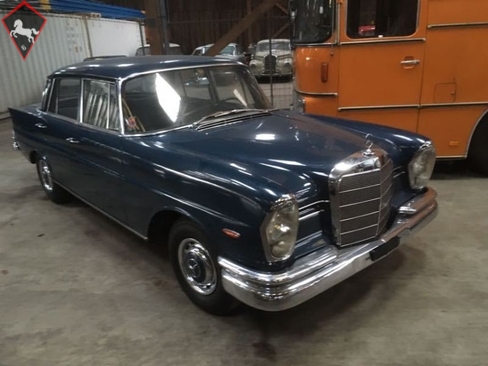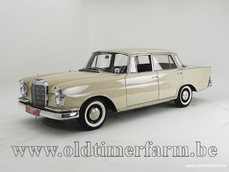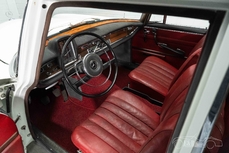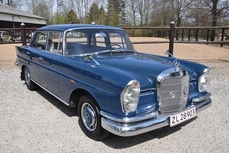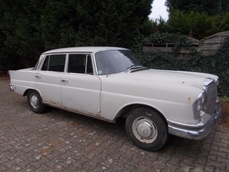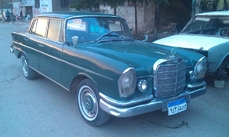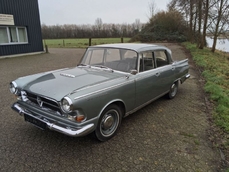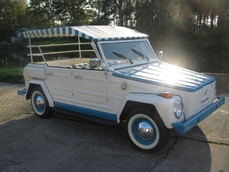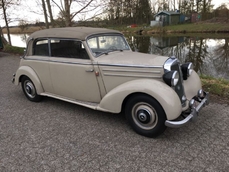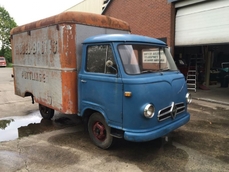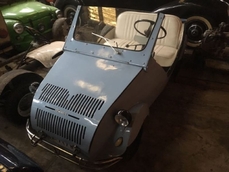Mercedes-Benz 220S w111 Fintail SE 1960
General description :
Informationen auf Deutsch
Weitere Informationen
Karosserieform: Limousine
Türenzahl: 5
Zylinderzahl: 6Informatie in het Nederlands
Opmerkingen
Dit is een mooie optionele rij auto met een modern gevoel maar toch een prachtig klassiek uiterlijk.
De Mercedes-Benz W111 was een chassiscode voor een reeks Mercedes-voertuigen geproduceerd tussen 1959 en 1971, waaronder vierdeurs sedans (1959-1968) en tweedeurs coupés en cabriolets (1961 tot 1971). Geïntroduceerd als inline 6-cilinderauto's met 2.2-liter motoren, heeft de W111 twee varianten ontwikkeld: instapmodellen die het chassis en de carrosserie delen, maar met motoren verschilden werden W110 genoemd. Een luxe versie gebouwd op het W111 chassis met zijn carrosserie en de brandstofinjecteerde 3-liter M186 zescilindermotor werd aangewezen als de W112.
Dies ist ein schönes optionales Auto mit einem modernen Gefühl, aber immer noch eine schöne klassische Optik.
Der Mercedes-Benz W111 war ein Fahrgestellcode für eine Reihe von Mercedes-Fahrzeugen, die zwischen 1959 und 1971 produziert wurden, darunter viertürige Limousinen (1959-1968) und zweitürige Coupés und Cabriolets (1961 bis 1971). Als Inline-6-Zylinder-Fahrzeuge mit 2,2-Liter-Motoren eingeführt, hat der W111 zwei Varianten entwickelt: Einstiegsmodelle, die das Chassis und Karosserie teilen, aber mit Vierzylinder-Motoren als W110. Eine Luxusversion, die auf dem W111-Chassis mit seiner Karosserie und dem 3-Liter-M186-Sechszylindermotor mit Einspritzung gebaut wurde, wurde als W112 bezeichnet.
---
This is a beautiful optional driving car with a modern feel but still a beautiful classic look.
The Mercedes-Benz W111 was a chassis code given to a range of Mercedes' vehicles produced between 1959 and 1971, including four-door sedans (1959-1968) and two-door coupés and cabriolets (1961 to 1971). Introduced as inline 6-cylinder cars with 2.2-litre engines, the W111 spawned two lines of variants: entry-level vehicles sharing its chassis and bodies but with four-cylinder engines were designated the W110. A luxury version built on the W111 chassis with its body and the fuel-injected 3-litre M186 six-cylinder engine was designated the W112.
Meer informatie
Carrosserievorm: Sedan
Aantal deuren: 5
Aantal cilinders: 6
BTW/marge: BTW niet verrekenbaar (margeregeling)
Bedrijfsinformatie
Zaterdags geopend van 09-13 uur, de rest van de week op afspraak.
Samstag 9-13 uhr geöffent rest der woche auf termin. Wir können auf Wunsch für Ihr Fahrzeuge den TÜV absolvieren, und ein H.gutachten erstellen.Wir sind 7km von die Deutsche grenze. Besichtigung nur nach Terminvereinbarung!
We are open on Saturday 9-13 hour, rest of the week on appointment. We can arrange German, or other papers for the car. We are located 7 km from the German border. Car can be seen_...
1960 Mercedes-Benz 220S w111 Fintail SE is listed for sale on ClassicDigest in Ettensestraat 19NL-7061 AA Terborg by POTOMAC CLASSICS B.V. for €22500.
Car Facts
Car type : Car Make : Mercedes-Benz Model : 220S w111 Fintail Model Version : SE Engine size : 2.2 Model Year : 1960 Sub type : Sedan Location : Ettensestraat 19NL-7061 AA Terborg Vehicle Registration : Undefined
22500 €
People who viewed this Mercedes-Benz 220S w111 Fintail also viewed similar Mercedes-Benz listed at ClassicDigest
Other cars listed for sale by this dealer
About Mercedes-Benz
In the annals of automotive history, the journey of Mercedes-Benz is a tale that unfolds with the ingenuity of its founding pioneers. In the year 1886, Karl Benz crafted the Benz Patent Motorwagen, a creation that would go down in history as the world's inaugural automobile. Unbeknownst to him, this moment marked the genesis of what would evolve into the most illustrious premium car manufacturer globally. The financial underpinning of this pioneering venture, interestingly, was provided by Karl Benz's wife, Bertha Benz, demonstrating a remarkable partnership that would set the tone for Mercedes-Benz's legacy.A parallel narrative emerged not far away, as Daimler-Motoren-Gesellschaft, founded by Gottlieb Daimler and Wilhelm Maybach, entered the scene. In 1901, they unveiled their automobile under the now-famous moniker "Mercedes," meaning "godsend" in Spanish. This name was bestowed upon the car at the behest of Emil Jellinek's daughter, the distributor for Daimler-Motoren-Gesellschaft. The wheels of innovation were set in motion.
Fast forward to 1926, a pivotal year that witnessed the merger of Daimler with Benz & Cie., culminating in the birth of Daimler-Benz. The amalgamation saw the adoption of "Mercedes-Benz" as the distinguished trademark for their automobiles, fusing the legacies of two visionary entities into one.
Contrary to perceptions of conservatism, the trajectory of Daimler-Benz unfolds as a chronicle of industry firsts. From the introduction of the honeycomb radiator to the float carburetor, and the pioneering implementation of four-wheel brakes in 1924, Daimler-Benz consistently pushed the boundaries of automotive innovation. The diesel-powered Mercedes-Benz 260 D in 1936 marked the inception of diesel engines in passenger cars. The iconic Mercedes-Benz 300SL Gullwing made history as the first car with direct fuel injection, albeit the Gutbrod's tiny 2-stroke engine can claim precedence.
Safety innovations became a hallmark, with Béla Barényi's patented safety cell design in the "Ponton"-models in 1951, featuring front and rear crumple zones. The W116 450SEL 6.9 saw the introduction of the Anti-Lock Brake system (ABS), another pioneering safety feature. From the first production airbags and beyond, the legacy of "firsts" continued to be etched into the fabric of Daimler-Benz.
Over its centennial journey, Mercedes-Benz has not merely produced cars but has sculpted automotive icons. The SSKL, 710 SSK Trossi Roadster, 770K Grosser, 540K Spezial Roadster, 300SL Gullwing, w100 600 Pullman, w111 280SE 3.5 Flachkühler, w113 230SL Pagoda, w109 300 SEL 6.3, and w201 2.3-16 Cosworth stand testament to the brand's commitment to engineering excellence.
The roaring Silver Arrows, or "Silberpfeile," including the W 25, W 125, W154, W165, and W196, created a legacy of dominance on the racetrack. These machines were not merely cars; they were expressions of precision, speed, and an indomitable spirit that left their competitors in the dust.
As Mercedes-Benz marches into the future, it does so not just as an automaker but as a custodian of a legacy, a torchbearer of innovation, and a beacon of automotive excellence. The road ahead is sure to witness the continued fusion of cutting-edge technology, timeless design, and an unwavering commitment to setting new standards in the world of automobiles.
One luminary figure who left an indelible mark was Béla Barényi, often heralded as the "father of passive safety" for his pioneering work in safety engineering. His patented safety cell design, featuring front and rear crumple zones, became a hallmark of Mercedes-Benz's commitment to occupant safety, setting new standards that reverberated throughout the automotive world.
Moving through the chronicles, the collaborative genius of Wilhelm Maybach, alongside Gottlieb Daimler, laid the foundation for Daimler-Motoren-Gesellschaft. Their innovations not only birthed the first Mercedes but established a culture of relentless pursuit of technological excellence that remains integral to Mercedes-Benz's DNA.
In the post-merger era of 1926, Ferdinand Porsche emerged as a prominent figure within Mercedes-Benz. His work on the Mercedes-Benz S-Type, a supercharged race car, garnered acclaim and set the stage for a legacy that extended far beyond the marque. Porsche's impact would later extend to his eponymous company, but his influence at Mercedes-Benz during those formative years was pivotal.
As the 20th century progressed, the legendary Rudolf Uhlenhaut emerged as a key figure. Uhlenhaut, an accomplished engineer and the driving force behind the iconic Silver Arrows, played a crucial role in Mercedes-Benz's dominance in motorsports. His engineering prowess and attention to detail were instrumental in creating some of the most formidable racing cars of the era.
In the latter half of the century, figures like Bruno Sacco, the head of design at Mercedes-Benz from 1975 to 1999, left an indelible imprint on the brand's aesthetic identity. Sacco's design philosophy, characterized by clean lines and timeless elegance, shaped iconic models like the W126 S-Class and the W201 190E, solidifying Mercedes-Benz's reputation for luxury and sophistication.
The narrative would be incomplete without acknowledging the contributions of engineers like Hans Scherenberg, whose leadership in the 1970s ushered in a new era of technological innovation at Mercedes-Benz. Scherenberg's tenure saw the development of groundbreaking technologies, including the Anti-Lock Brake system (ABS) and the introduction of airbags in production cars.
